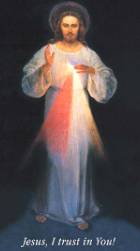CATECHESIS Q & A: DEEPENING OUR KNOWLEDGE
“What is the Divine Mercy Message and Devotion?"

"What is the Divine Mercy Message and Devotion?" Beginning in February 1931, St. Faustina Kowalski, a Polish nun reported receiving visitations from Jesus. One of the things He asked her for was that a painting be made of the vision of His Merciful Heart and that a Feast of Divine Mercy be established on the first Sunday after Easter. She also related that Jesus told her, “I am offering people a vessel with which they are to keep coming for graces to the fountain of mercy. That vessel is this image (shown to the right) with the signature: ‘Jesus, I trust in You.’ The two rays denote Blood and Water. The pale ray stands for the Water which makes souls righteous. The red ray stands for the Blood which is the life of souls. These two rays issued forth from the very depths of My tender mercy when My agonized Heart was opened by a lance on the cross.”
St. Faustina also, in obedience to her spiritual director, wrote a diary of about 600 pages recording the revelations she received. Even before her death in 1938, the devotion to The Divine Mercy had begun to spread. According to St. Faustina’s diary, Our Lord promised that all those who would receive Him in Holy Communion and go to Confession on the Sunday after Easter “shall obtain the complete forgiveness of sins and punishment.” The message and devotional practices proposed in the Diary of Saint Faustina are completely in accordance with the teachings of the Church and are firmly rooted in the Gospel message of our Merciful Savior. Properly understood and implemented, they will help us grow as genuine followers of Christ. When St. John Paul canonized her in 2000, he proclaimed that the Second Sunday of Easter would be known from then on as Divine Mercy Sunday, thereby widely promoting the devotions associated with Faustina’s visions.
The message of The Divine Mercy is simple. It is that God loves ALL of us, and He wants us to recognize that His mercy is greater than our sins, so that we will call upon Him with trust, receive His mercy, and let it flow through us to others. Thus, all will come to share His joy. We can recall the message to mind simply by remembering ABC: A - Ask for His Mercy. God wants us to approach Him in prayer constantly, repenting of our sins and asking Him to pour His mercy out upon us and upon the whole world; B - Be merciful. God wants us to receive His mercy and let it flow through us to others. He wants us to extend love and forgiveness to others just as He does to us; C - Completely trust in Jesus. God wants us to know that the graces of His mercy are dependent upon our trust. The more we trust in Jesus, the more we will receive.
PLENARY INDULGENCE: Our Lord promised that all those would attend Mass and receive Holy Communion on Divine Mercy Sunday, as well as go to Confession and pray for the intentions of the Holy Father would obtain “complete forgiveness of their sins and punishment.” Alternatively, the promise extends to those who, in the presence of the Blessed Sacrament, recite the Our Father and the Creed, adding a devout prayer to the merciful Lord Jesus (e.g. Merciful Jesus, I trust in you!") and go to Confession and pray for the intentions of the Holy Father. In 2002, Pope John Paul extended the promise so that Confession can be made up to 20 days before or after Divine Mercy Sunday. Be sure to join us and encourage others to come—especially those who may wish to return to the practice of their faith!
|
Article No. 39 (Published in the Bulletin of April 3, 2016)